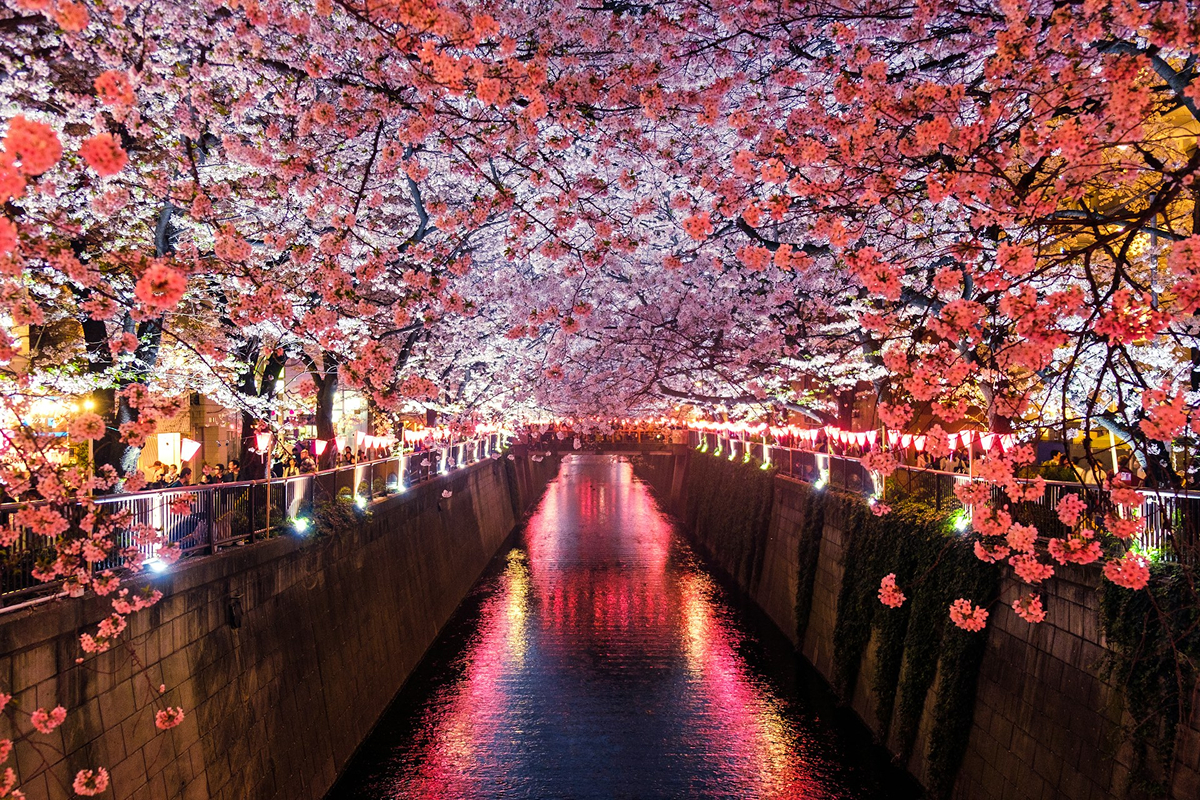When should you go to Japan?

Table of contents:
Japan's climate varies greatly from north to south. The seasons are therefore very marked, and the period during which you plan to travel there will have a direct impact on your stay and the activities available once you're there.
There are 4 seasons in Japan, as follows:
- Spring, from April to May, with temperatures ranging from 2 to 24°C.
- Summer, from June to August, with temperatures ranging from 16 to 30°C.
- Autumn, from September to November, with temperatures ranging from 7 to 27°C.
- Winter, from December to March, with temperatures ranging from -6 to 20°C.
It's hard to pick one season over another for a trip to Japan. The country has everything to amaze you, all year round.
Spring in Japan
Spring is one of the most popular times to discover Japan. You can enjoy pleasant weather throughout most of the country.
Flowers are an integral part of Japanese culture, and it's during this season that the country displays its most beautiful palette of colours. These include the famous Sakura, a magnificent pink flower that symbolises Japan, as well as plum, Fuji, Churripu and cherry trees.
You can admire Japanese flora in the Shinjuku Gyoen national garden and Ueno Park. The Ashikaga Floral Park in Tochifi and the Kawachi Wisteria Garden in Fukuoka are also must-sees for flower lovers.
However, this is a very touristy time of year, which is bound to push up your budget. So remember to book your tickets well in advance to avoid excessively high prices.
Summer in Japan
The Japanese summer is generally divided into two parts:
- June, with heavy rain;
- July and August, with hot, humid days.
This is a particularly intense season, as the high temperatures and high humidity can be overwhelming. As a result, you're likely to be sweltering as soon as you step outside. As you can see, this time of year can be particularly hard to bear. Rest assured, however, that travelling in Japan during the summer also allows you to discover another facet of the country and local life.
Given the weather during this season, you'll be able to take advantage of the lakes, beaches and rivers that abound in the country. Water activities such as surfing, rafting and diving are therefore very popular during this period.
You can also head to the mountainous areas to take advantage of the milder weather and discover breathtaking scenery.
Numerous festivals and events are also held during the summer, offering a total immersion in the country's culture. Taking part in the Gion Matsuri, one of Japan's most famous festivals, is a unique experience and a must. This event, created in 869 by Emperor Seiwa to ask the gods to protect Kyoto from the plague, takes place all over the city throughout July. It features float parades, street performances and a host of culinary specialities. The Yamaboko Junko, the festival's main parade, has been declared a UNESCO World Heritage Site.
The Nebuta Matsuri is another not-to-be-missed summer event. This festival is held in the city of Aomori at the beginning of August and is famous for the procession of giant lanterns that takes place every day in the city. The procession is accompanied by the sound of taiko drums, musicians and dancers taking part in the ceremony. The final day of the festival is marked by a grand fireworks display. It's perfectly possible to take part in the festival, as long as you wear a traditional haneto dance costume. Go to a local grocery shop to get yours and take part in this unique event!
Reserve your currency online
Enjoy the best exchange rates and 0% commission when booking your travel money online.
Autumn in Japan
Autumn, like spring, is a season of milder temperatures and stunning colours.
The Rikugien Garden is a must-see if you're visiting Tokyo to enjoy the autumn colours. Lake Kawaguchiko, at the foot of Mount Fuji, is another destination not to be missed during this season. Many varieties of flowers bloom in autumn, including chrysanthemums, Japanese amaryllis and cosmos.
Several festivals are also held during this period. The Aki Matsuri (Autumn Festival), for example, has been held for over 50 years in the town of Kichijoji during the second weekend in September. Local people carry portable altars through the streets throughout the day until they arrive at the Hachimangu shrine.
The Fukuro Matsuri is another highlight not to be missed. Organised in Ikebukuro since 1968, it takes place in two parts: the first in September with the parade of the mikoshi, a portable shrine, and the Tokyo Yosakoi dance festival in October, which features numerous traditional dances and musical performances.
Winter in Japan
The cold invades the country in winter, so it's a good idea to take some warm clothes with you if you plan to travel there during this season. Ski and snowboard slopes are plentiful throughout the country, so you can enjoy winter sports as early as December. So if you're a thrill-seeker, going to Japan in winter is an excellent choice!
The country also offers a completely different cuisine during the cold season. For example, you can enjoy a variety of stews and pot-au-feu to warm you up. These include the traditional Oden, Sukiyaki and Shabu-shabu.
Celebrating Christmas in Tokyo is also an unforgettable experience. The city is completely decorated and lit up with breathtaking garlands. The Japanese New Year is also a festival not to be missed, full of traditions: Toshikoshi Soba tasting, the 108 bells ritual and the first sunrise!
You can also take part in several winter festivals, such as the Sapporo Snow Festival, which attracts millions of visitors every year. Celebrated in the city of the same name since 1950, the event takes place every year from the end of January to the beginning of February and features a host of snow and ice sculptures.
You can also attend the Yokote Kamakura festival, during which the city is decked out in thousands of illuminated igloos. More than 450 years old, it's a magical spectacle that makes for unforgettable night-time strolls.
-
How to read an exchange rates table?
July 4, 2025
-
When is the Best Time to Exchange Currency?
June 30, 2025
-
4 Food Destinations to Explore in Thailand
June 30, 2025

















